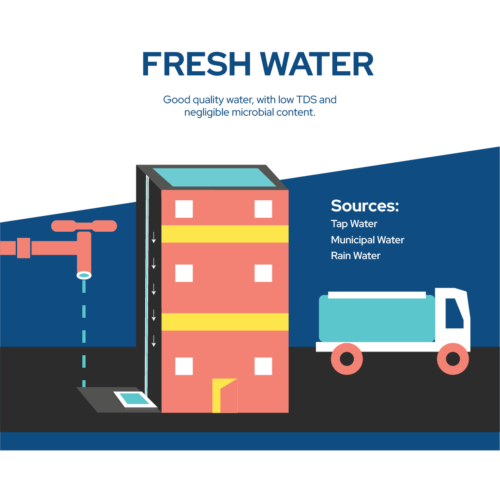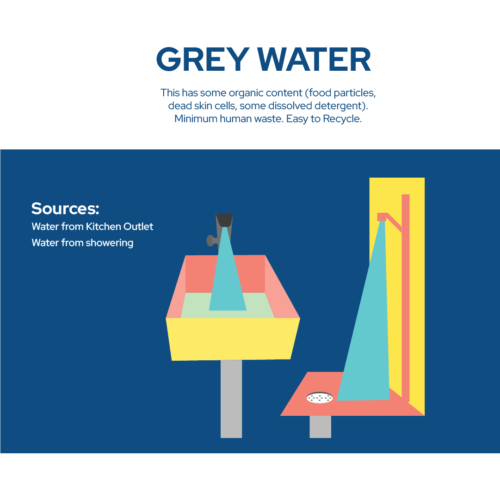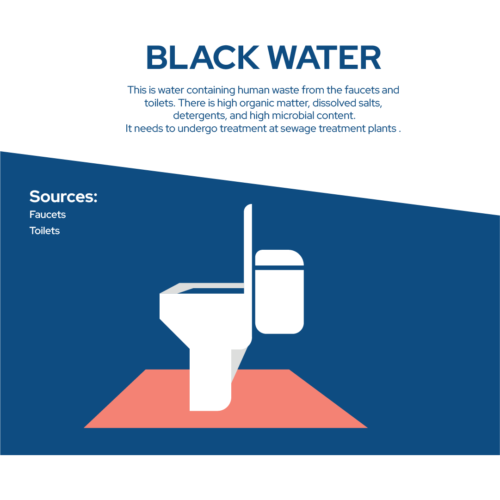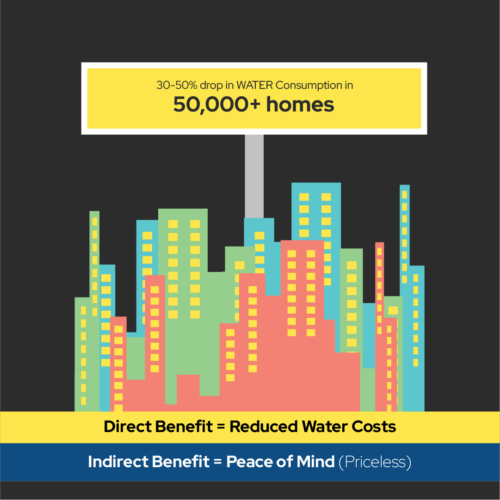Water shortages, depleting water table, erratic supply by the municipality and water tankers – summer can be a nightmare for residents in cities across India. This usually means spiraling maintenance costs and increased conflict among residents.
Who uses more water?
Who is paying for the water?
Is it fair to charge everyone the same amount in maintenance?
If you are part of a Residents’ Welfare Association, this probably sounds familiar. But before you handle the high emotions, lets look into the three types of water in every building.
Freshwater (or white water), grey water, and black water.
1. Freshwater – Water supplied by the municipality or corporation, purchased from water tankers, or extracted from underground sources using borewells and pumps. This is good quality water, with low TDS and negligible microbial content. Water from various sources – municipality, tankers, borewells – is stored in sumps and pumped to overhead tanks. The water in taps, showers, and toilets come from these storage units.

2. Grey water – Waste water from the washing machine, dishwasher, waste water after showering, water from the kitchen sink, wash basins. Grey water is released from outlets in the kitchen, the shower and the service area. This has some organic content (food particles, dead skin cells, some dissolved detergent). But it doesn’t contain human waste. Grey water is relatively easy to reuse. It can be filtered and allowed to re-enter the groundwater, and replenish underground aquifers. With judicious choice in detergents, soaps and shampoos, this process can be made even simpler. Some detergents, like powdered soapberries, generate grey water that can be used in gardening, without any need for treatment or filtration.

3. Black water – This is water containing human waste from the faucets and toilets. There is high organic matter, dissolved salts, detergents, and high microbial content. It is hazardous to handle. Black water needs to undergo treatment at sewage treatment plants – locally and at the municipal level. If it mixes with freshwater sources, it can cause public health crises. In metro cities like Bengaluru, Mumbai and Chennai, demand for fresh water is quickly outstripping supply. Every city is trying to handle this by increasing supply. They are accessing water from watershed regions, distant rivers and lakes. Some are trying to increase rainwater harvesting.
However, there is an important piece in this puzzle – reducing demand.
On the face of it, it sounds ridiculous. Population in cities is increasing, population density is increasing. It makes sense that consumption of water will increase.

However, there are numerous benefits to reducing demand –
1. Lowered water bills – This is the most obvious benefit of reducing water consumption. In multi-dwelling units like apartment complexes, water from the municipality has to supplemented by water from tankers and through pumping groundwater. Quality of water from tankers can be unreliable, and when there is high demand, supply of tankers can be unpredictable. They are also expensive. Groundwater might need to be treated before it can be used.
2. Pay per use – Many utilities are considering implementing a telescoping billing method. Those who use less water will be charged less per litre. Moving from a higher slab to a lower slab will not only reduce the overall bill, but also reduce the cost of water per litre.
Lower consumption = Reduced water bills.
3. Reduced electricity bills – Pumping water from borewells and storage tanks to overhead tanks takes a lot of energy, and leads to high electricity bills. When consumption reduces, the work of the motor becomes less. The building spends less on electricity bills.
4. Increased lifespan of motors – Using the motor for a shorter period of time also enhances its longevity. There are fewer repairs from wear and tear. Motor replacement will happen less frequently.
5. Reduced burden on the water treatment plant – in cities like Bengaluru, grey and black water needs to be treated before it is released into the sewerage system. If the building water consumption reduces by 50%, the money and effort spent on water treatment will come down significantly.

Our experience with 50,000+ homes across the country tells us that there is room to reduce consumption. With accurate sensors and real-time monitoring on our app, we see a drop in consumption of between 30-50%.
For instance, people living in Appaswamy Cityside Apartments (Chennai), were able to reduce water usage by 50% and resolve conflict among residents. Residents of Landmark Vertica achieved Return on Investment (RoI) through water savings in just 5 months!
Direct benefit = reduced water costs
Indirect benefit = peace of mind (priceless!)
To know more about how a comprehensive water management system can work for you, sign up for a free site-evaluation.
